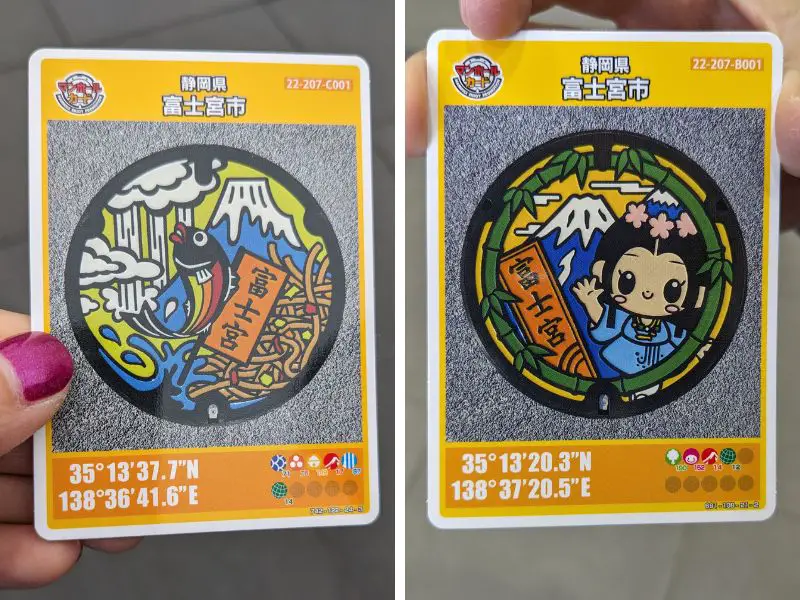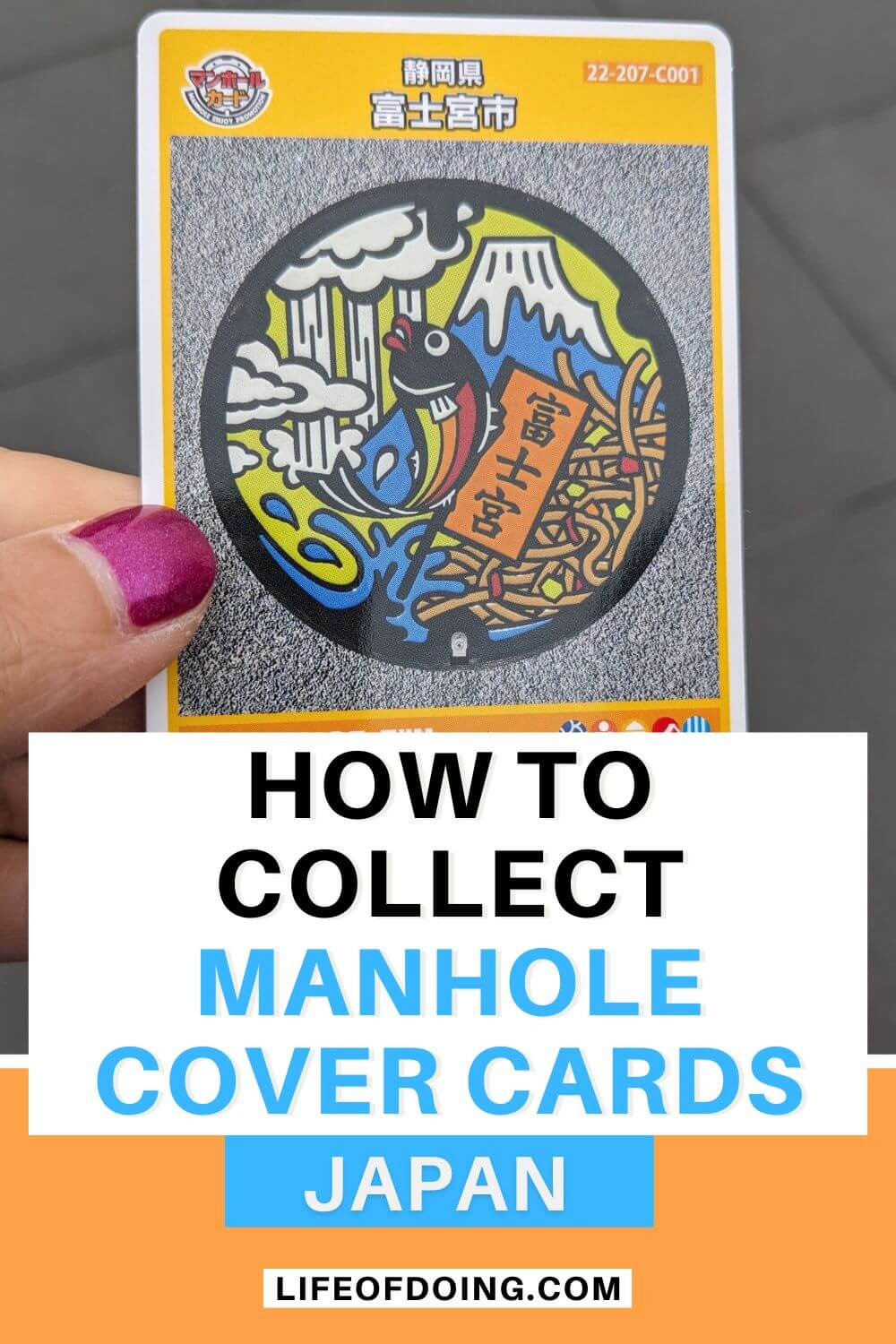During our Japan travels, Justin and I have a new obsession – collecting manhole cover cards!
You may recall my love for finding Pokemon Poke Lids around the country and Sailor Moon manhole covers in Tokyo.
Now, there are manhole cover cards to add to the things to collect from Japan. They’re free to get in many of the Japanese Prefectures!
We recently found out about the cards in late 2024 after accidentally collecting one from a stamp rally in Kawaguchiko. So, we’ve missed out on many cards from our earlier trips. Oh well! It means that we need to revisit places to collect the cards.
We have 23 in our collection from Tokyo, Nara, Osaka, Yokohama, and Shizuoka. There are hundreds in the current distribution.
Since there isn’t much information about these manhole cards, we wanted to share our tips on how to find these cards.
*Disclaimer: This post contains affiliate links. If you click on them and make a purchase, we receive a small commission. There is no additional cost to you. Appreciate the support.
What Are Manhole Cover Cards?
GKP is a Sewage Public Relations Platform that promotes and provides awareness of Japan’s sewage system. This group partners with local governments to spark interest in the sewage system.
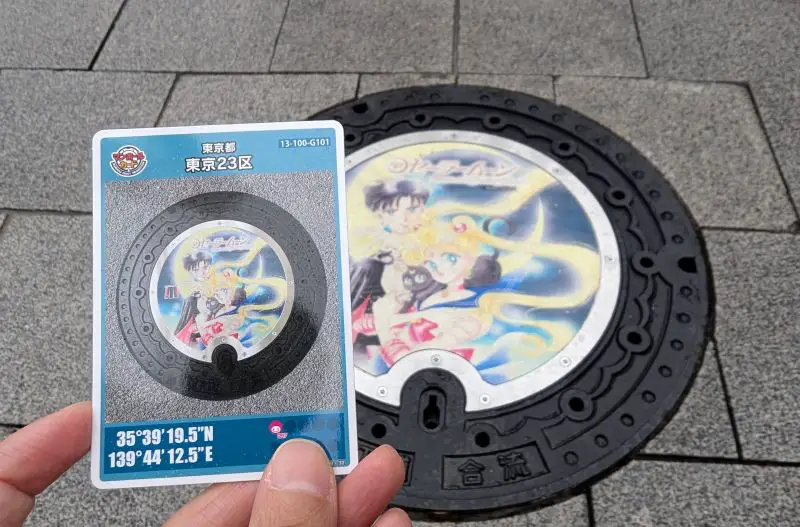
We love collecting manhole cards, and this one highlights the Sailor Moon, Tuxedo Mask, and Luna manhole cover in Tokyo’s Minato ward.
You will see uniquely designed and sometimes colorful manhole covers scattered throughout the city, such as next to the train station, on the sidewalks, and more.
Many prefectures offer manhole cards at selected locations to encourage people to learn about their local city’s manhole cover design, the city’s history, or any cultural significance.
Note: The cards are in Japanese. But you can use a Translation app to translate.
Front of Card
The front of the card has the highlighted manhole cover design in the middle, the coordinates of the highlighted manhole cover in the lower right corner, and small icons in the right corner.
The GPS coordinates have the location of the manhole cover. But sometimes you can find the same manhole cover near the train station or in high traffic areas.
The small icons are symbols that represent the card. For example, there is a pink and white flower for a flower, a green and white tree for a tree, a purple and white bird for a bird, etc. This blog post has a photo of the icon pictogram and what each icon means. (The pictogram is in Japanese but you can use your Translation app.)
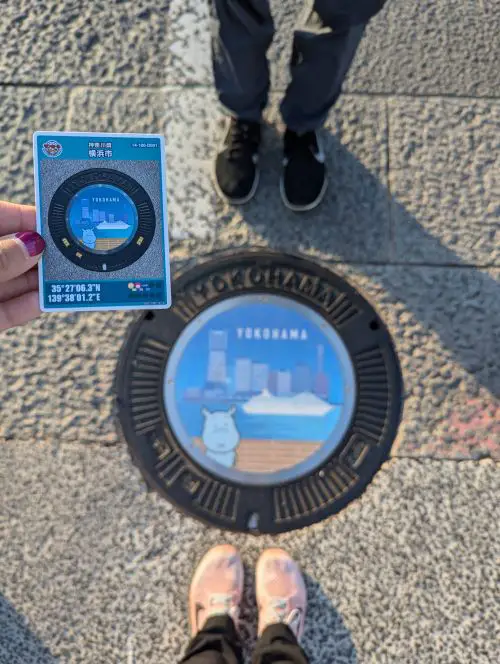
This is one of the manhole cards from Yokohama
For example, this Yokohama hippo card has three icons –
- Orange and white bell for tourist attraction (For this card, it’s the Minato Mirai 21 waterfront)
- A pink and white smiley face for a character (It’s Hippo Dai-Chan)
- A blue and white wave for sea (Yokohama is a port town so it’s surrounded by water.)
Back of Card
The back of the card has history and other information about the design, when the manhole cover was installed, or city highlights. The lower left corner of the card has the distribution location.
Here is the back of the Yokohama hippo card.
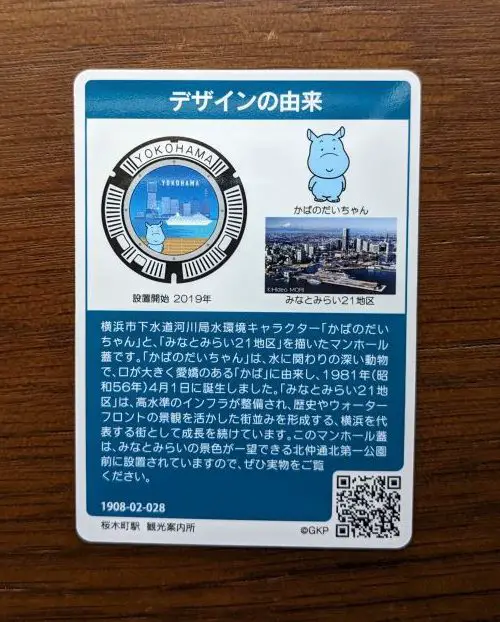
Back of the Yokohama manhole card
Why Collect the Cards?
It’s a fun hobby and one of the memorable things to do when traveling to various parts of Japan.
Travelers and tourists collect rubber stamps at train stations and attractions, goshuin (shrine and temple stamps), and stamp rallies. So, add manhole card collecting to the mix!
The card collecting tends to be still a secret as they’re not as accessible as collecting a stamp.
It requires some time to research card locations and pick up the cards at tourist information centers, city government buildings, attractions, etc. (While the cards do not have a cost, some attractions require an admission fee.)
Cards cannot be required over email or shipped, so you must go to the pick up location in person. Also, there is a limit of one card per person.
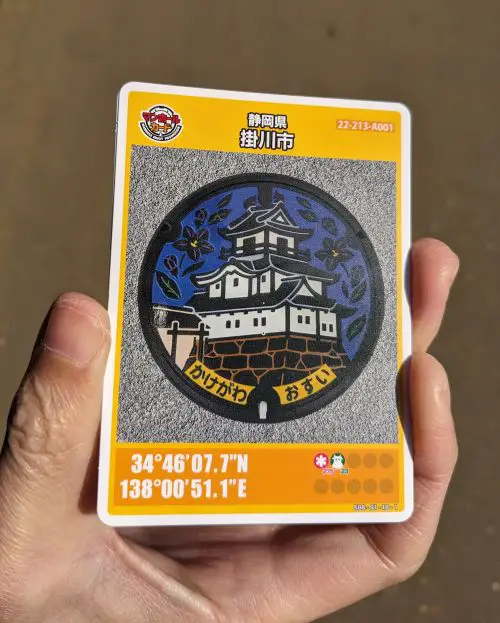
Kakegawa manhole card
After getting one, it’s addictive to find more!
If you’re on Facebook, you can join this public Japan Manhole Cover Club Facebook group and see what manhole covers and cards members find.
How to Find the Manhole Card Locations
Step 1: Go to this website. It will be in Japanese, so you will need to “Translate” it from your browser. In the Chrome browser, click on the three dots in the upper right corner, then click “Translate.”
Step 2: After translating the website, scroll to a green box that says, “Manhole card search.”
Step 3: Click on the dropdown menu to a specific Prefecture, such as Hokkaido, Tokyo, Osaka, etc. Click on the yellow “Search” button.
Step 4: A spreadsheet has the headers – City, Manhole Card Design, Card Number Version, Manhole Card Issue Date, Distribution Location, Distribution Time, and Availability.
Scroll through the list and find the cards that you’re interested in getting.
Step 5: Click on the link in the “Availability” column for current updates such as how many cards are left, distribution locations for weekdays and weekends (locations may change), information about the manhole card, and/or additional information on manhole covers in the city.
Step 6: Visit the distribution location, ask for the manhole card, and start collecting!
TIP: We suggest saving the distribution locations on Google Maps so you will have the address ready. You can also add a note on the distribution times. The times are strict so please leave plenty of time for pick up.
If the Customer Service representative does not understand the manhole card, we show a photo of the card design from the manhole card website.
Some distribution locations require you to complete a short questionnaire before receiving the card. The questionnaire is usually in Japanese so we used Google Translate to translate the questionnaire. It asks general information such as nationality, age, how many days we’re in the city if we know about the manhole covers, etc. The questionnaire takes less than 1 minute to complete.
Step 7: Organize your collection in a booklet.
After collecting over a dozen cards, it was time to organize them in a booklet/binder.
We went to Daiso in Japan (but there are Daiso’s in many countries) and bought a small card protector booklet. It has clear plastic card sleeves that hold over 100 cards (4 cards per page). The plastic is thin, but it does the job.
We organized the cards by Prefecture and then by GPS coordinates from North to South. In Nara, we received two shrine and manhole cards at the same time, so we added them to the booklet.
Final Thoughts
If you like card collecting, then the Japanese manhole cards will be a great addition to the collection. They’re also one of a kind due to the limited quantities.
All you need to do is factor in extra time in your itinerary to pick them up at the distribution locations, but they’re worth it.
For the hardcore collectors, there is an annual Manhole Summit in October or November. The location changes every year. If you know Japanese, then this would be an exciting Summit to experience. Click here to learn more and see the past summits.
Happy collecting!
If you like this post, save it to your Japan Travel Pinterest Board.

